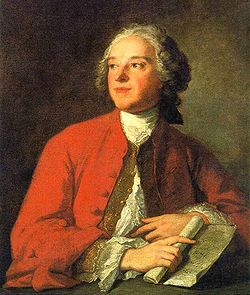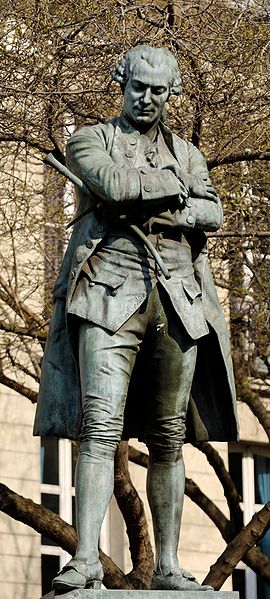<Back to Index>
- Economist Oskar Morgenstern, 1902
- Playwright Pierre de Beaumarchais, 1732
- Duke of Milano Galeazzo Maria Sforza, 1444


Pierre-Augustin Caron de Beaumarchais (24 January 1732 – 18 May 1799) was a watchmaker, inventor, musician, diplomat, fugitive, spy, publisher, arms dealer, and revolutionary (both French and American). He was best known, however, for his theatrical works, especially the three Figaro plays.
Beaumarchais was born Pierre-Augustin Caron, the only boy among the six children of a watchmaker. Caron left school at the age of 13 to apprentice under his father. In July of 1753, at the age of 21, he invented an escape mechanism for watches that allowed them to be made substantially more accurate and compact. One of his greatest feats was a watch mounted on a ring, made for Madame de Pompadour, a mistress of Louis XV. The invention was later recognised by the Académie des sciences, but only after a dispute with M. Lepaute, the royal watchmaker, who attempted to pass off the invention as his own.
In 1758-59, Caron became the harp tutor to King Louis XV's daughters. In 1759-60, Caron met Joseph Pâris-Duverney,
an older and wealthy entrepreneur. The two became very close friends
and collaborated on many business ventures. Shortly after his first
marriage in 1756,
Caron adopted the name "Pierre-Augustin Caron de Beaumarchais", which
he derived from "le Bois Marchais", the name of a piece of land
inherited by his first wife. Assisted by Pâris-Duverney, Beaumarchais acquired the title of secretary-councillor to the King in 1760-61, thereby gaining access to French nobility. This was followed by the purchase of a second title, the office of lieutenant general of hunting in
1763. The following year, Beaumarchais began a 10-month sojourn in
Madrid, supposedly to help his sister, Lisette, who had been abandoned
by her fiancé, Clavijo. It
was not long before Beaumarchais crossed paths again with the French
legal system. In 1787, he became acquainted with Mme. Korman, who was
implicated and imprisoned in an adultery suit, which was filed by her
husband to expropriate her dowry. The matter went to court, with
Beaumarchais siding with Mme. Korman, and M. Korman assisted by a
celebrity lawyer, Nicolas Bergasse.
On April 2, 1790, M. Korman and Bergasse were found guilty of calumny
(slander), but Beaumarchais's reputation was also tarnished. Meanwhile, the French Revolution broke
out. Beaumarchais was no longer the idol he had been a few years
before. He was financially successful, mainly from supplying drinking
water to Paris, and had acquired ranks in the French nobility. In 1791,
he took up a lavish residence across from where the Bastille once stood. He spent under a week in prison during August 1792, and was released only three days before a massacre took place in the prison where he had been detained. Nevertheless,
he pledged his services to the new Republic. He attempted to purchase
60,000 rifles for the French Revolutionary army from Holland, but was
unable to complete the deal. While he was out of the country,
Beaumarchais was declared an émigré (loyalists
to the old regime) by his enemies. He spent two and a half years in
exile, mostly in Germany, before his name was removed from the list of
proscribed émigrés. He returned to Paris in 1796, where
he lived out the remainder of his life in relative peace. He is buried
in the Père Lachaise Cemetery in Paris. Beaumarchais
married three times. His first wife was Madeleine-Catherine Franquet
(née Aubertin), whom he married on November 22, 1756, but died
under mysterious circumstances only 10 months following the marriage.
He later married Geneviève-Madeleine Lévêque
(née Wattebled) in 1768. Again, the second Mme. de Beaumarchais
died under mysterious circumstances two years later, though most
scholars believed she actually suffered from tuberculosis.
Beaumarchais had a son in 1770, Augustin, from his second marriage in
1770, but he also died in 1772. Beaumarchais lived with his lover,
Marie-Thérèse de Willer-Mawlaz, for twelve years, before
she became Beaumarchais's third wife, in 1786. Together they had a
daughter, Eugénie. In
his first two marriages, Beaumarchais was accused by his enemies of
poisoning them in order to lay claim to their family inheritance.
Beaumarchais, though having no shortage of lovers throughout his life,
was known to be caring for both his family and close friends. However,
Beaumarchais also had a reputation of marrying for financial gain, and
both Franquet and Lévêque were previously married to
wealthy families prior to Beaumarchais. While there was insufficient
evidence to support the accusations, whether or not the poisonings took
place is still subject of debate.
The passing of Pâris-Duverney in July 17, 1770 triggered a decade
of turmoil for Beaumarchais. A few months before his death, the two
signed a statement which cancelled all debts Beaumarchais owed
Pâris-Duverney (about 75,000 pounds), and granting Beaumarchais
the modest sum of 15,000 pounds. Pâris-Duverney's
sole heir, Count de la Blache, took Beaumarchais to court, claiming the
signed statement was a forgery. Although the 1772 verdict favoured
Beaumarchais, it was overturned on appeal in the following year by a
judge, magistrate Goezman, whose favour La Blache had managed to win
over. At the same time, Beaumarchais was also involved in a dispute
with Duke de Chaulnes over the Duke's mistress, which resulted in
Beaumarchais's being thrown into jail from February to May, 1773. La
Blache, took advantage of Beaumarchais's court absence and persuaded
Goezman to order Beaumarchais to repay all his debts with
Pâris-Duverney, plus interest and all legal expenses. To garner public support, Beaumarchais published a four-part pamphlet entitled Mémoires contre Goezman.
The action made Beaumarchais an instant celebrity, for the public at
the time perceived Beaumarchais as a champion for social justice and
liberty. Goezman countered Beaumarchais's accusations by launching a
law suit of his own. The verdict was equivocal. On February 26, 1774,
both Beaumarchais and Mme. Goezman (who sympathised with Beaumarchais)
were deprived of their civil rights, while Magistrate Goezman was
removed from his post. To restore his civil rights, Beaumarchais pledged his services to Louis XV and Louis XVI. He travelled to London, Amsterdam and Vienna on various secret missions. His first mission was to travel to London to destroy a pamphlet, Les mémoires secrets d'une femme publique, that Louis XV considered a libel of one of his mistresses, Madame du Barry.
Beaumarchais was also remembered for his essential support for the American Revolution. Louis XVI, who did not want to break openly with England, allowed Beaumarchais to found a commercial enterprise, Roderigue Hortalez and Co., supported
by the French and Spanish crowns, who supplied the American rebels with
weapons, munitions, clothes, and provisions, which would never be paid
for. Beaumarchais would deal with Silas Deane,
an acting member of the Second Continental Congress's Committee of
Secret Correspondence. For these services, the French Parliament
reinstated his civil rights in 1776. Shortly after the death of Voltaire in
1778, Beaumarchais set out to publish Voltaire's complete works, many
of which were banned in France.